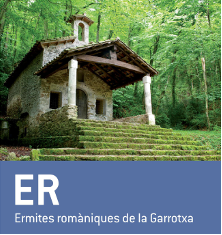In La Garrotxa there is an exceptional sample of the architectural legacy of the Middle Ages. Of all the places where this rich heritage is preserved, two generally stand out from all the rest: Besalú and Santa Pau.
The Royal Cúrial, the old Palace of Justice seat of the Vegueria and Royal Court; the old Monastery of Sant Pere, one of the most characteristic Romanesque temples in the country; Sant Vicenç, an example of the Romanesque harmony between construction and rustic surroundings; and the Old Bridge, fortified and angled, these are some of Besalú's most important Romanesque structures.
Santa Pau is La Garrotxa's other highlight from the Middle Ages. The castle, which is not open to the public, presides over the village, perfectly sealed and enclosed by an ancient wall. With its irregular shape and almost completely arcaded, the village's main square, overlooked by Santa Maria church, is not to be missed. The narrow and steep alleyways, the large windows, gateways and arches are Santa Pau's real attraction.
La Garrotxa's most notable monasteries are Sant Pere de Besalú, Sant Llorenç de Sous, Riudaura, Sant Ferriol and Sant Joan les Fonts, where the medieval castle Estada Juvinyà, a Romanesque building that houses the Territorial Interpretation Centre, is also located.
La Garrotxa has a large concentration of Romanesque churches, especially in the Alta Garrotxa and the Besalú area. The earthquakes of 1427 and 1433 severely affected the Olot area, destroying many buildings. Sant Joan de Balbs, situated at La Pinya, is a jewel; Santa Bàrbara de Pruneres preserves a splendid sepulchral gravestone; Santa Maria d'Escales perches on a cliff; Sant Martí de Toralles; Sant Miquel del Corb, beside the forest; Sant Andreu de Socarrats; Santa Eulàlia de Begudà and, finally, the basilica of Sant Sepulcre de Palera.
Beget, in Ripollès county, is the architectural jewel of La Garrotxa. Sant Cristòfol church is an example of Romanesque design in its purest form and it is among the most interesting in Catalonia. Unlike other places of worship, it has preserved its heritage which, as well as the Romanesque Majesty of Beget carving, consists of a Gothic altarpiece, an interesting baptism font and several Baroque altars.
A visit to La Garrotxa brings you into contact with this art that is as old as it is interesting, and harks back to Christianity's most austere period.
One of the most notable events in La Garrotxa's history was enacted by Francesc de Verntallat, who led the Remences uprising, a revolt of the peasantry against their feudal lords. The Remences were peasants that were unable to abandon their land. This was because they could not free themselves from the landlords' control or stop being subject to the abuses imposed on them (abusive feudal customs that led to the Remences War between 1460 and 1486) without paying an amount set by the lord, or face harsh punishment. Verntallat took up the struggle and ended up securing, through an agreement known as La Sentència Arbitral de Guadalupe, the abolition of the tax and the feudal abuses and injustices. Francesc de Verntallat came from La Vall d'en Bas, and this valley and that of Hostoles were the main stages of the peasants' revolt against the unfair system.
Nowadays, these valleys still preserve some remnants of that period, such as Hostoles castle and Puig-alder castle, and these can be visited via several routes.
With regard to sculpture, the most important work is Crist en Majestat, which is in Sant Joan les Fonts monastery. This piece - a reproduction, since the original is kept in Girona's Museu Diocesà - can be seen by arranging a visit through the Tourist Office.
Romanesque
Routes and excursions TOP
-

Xenacs via ''the camí de les Barrincoles''and puig Rodó viewpoint. Route 2 Les Preses
The recreational area of Xenacs in Les Preses provides an atypical view of La Garrotxa and is one of the best places anywhere for getting a bird’seye view of Croscat and the other volcanoes in the area. As well, the height makes it an ideal place.
-

From Sadernes to Santa Bàrbara. Ruta 1 Alta Garrotxa
On clear days on certain stretches of this walk you can look eastwards and enjoy the views that extend right across the Empordà plain as far as the Mediterranean Sea.
-

Sant Pere Sacosta. Route 1 Les Planes d'Hostoles
The parish of Sant Pere Sacosta has the privilege of being one of the oldest and most remote inhabited villages of la Vall de Hostoles. Located on the slopes of la Serra del Puig del Moro, on the north ridge of el Far and below el Coll de Condreu.
-

The old trails of Batet. Route 1 Olot
Batet lies on a basalt plateau crowned by the volcano Pujalós. Batet is a wonderful place and provides exceptional views of the Pyrenees and the area around Olot.
-

El Talló. Route 6 Consorci Alta Garrotxa
Ascension to El Talló, a demanding peak and a great hiking tradition in the Alta Garrotxa area.
-

La Devesa and Caxurma caves. Route 1 Montagut i Oix
Baumes de Caxurma are a series of natural caves formed in the sedimentary rocks that lie to the south of the basalt cliffs of Castellfollit de la Roca. The largest cave is around 400 m in length.
-

Saint James's way
The St James’ Way runs through the county of La Garrotxa and visits en route a number of interesting sites.
-

El Mont from Segueró route. Ruta 4 Beuda
Route of 6.4 km the church of the Sanctuary of late Romanesque style, from the beginning of the 14th century.
-

The Romanesque churches of Maià de Montcal and Beuda
Maià de Montcal and Beuda are both good examples of La Garrotxa’s valuable cultural heritage and their wonderful Romanesque churches are the perfect excuse to visit this part of La Garrotxa.
-

The Romanesque churches of La Vall de Bianya
The traces of the history of La Vall de Bianya can be followed in this itinerary that visits the 15 Romanesque churches that decorate this peaceful corner of La Garrotxa.












